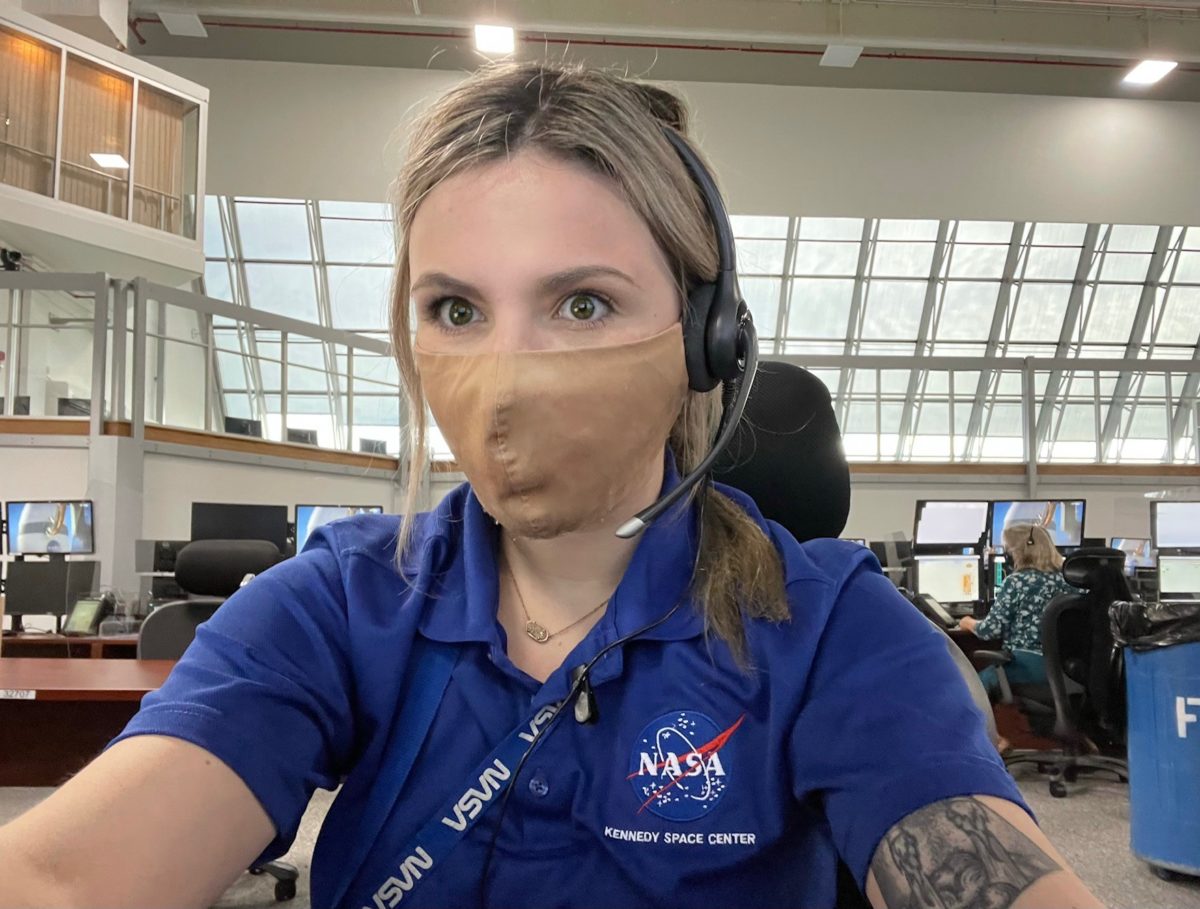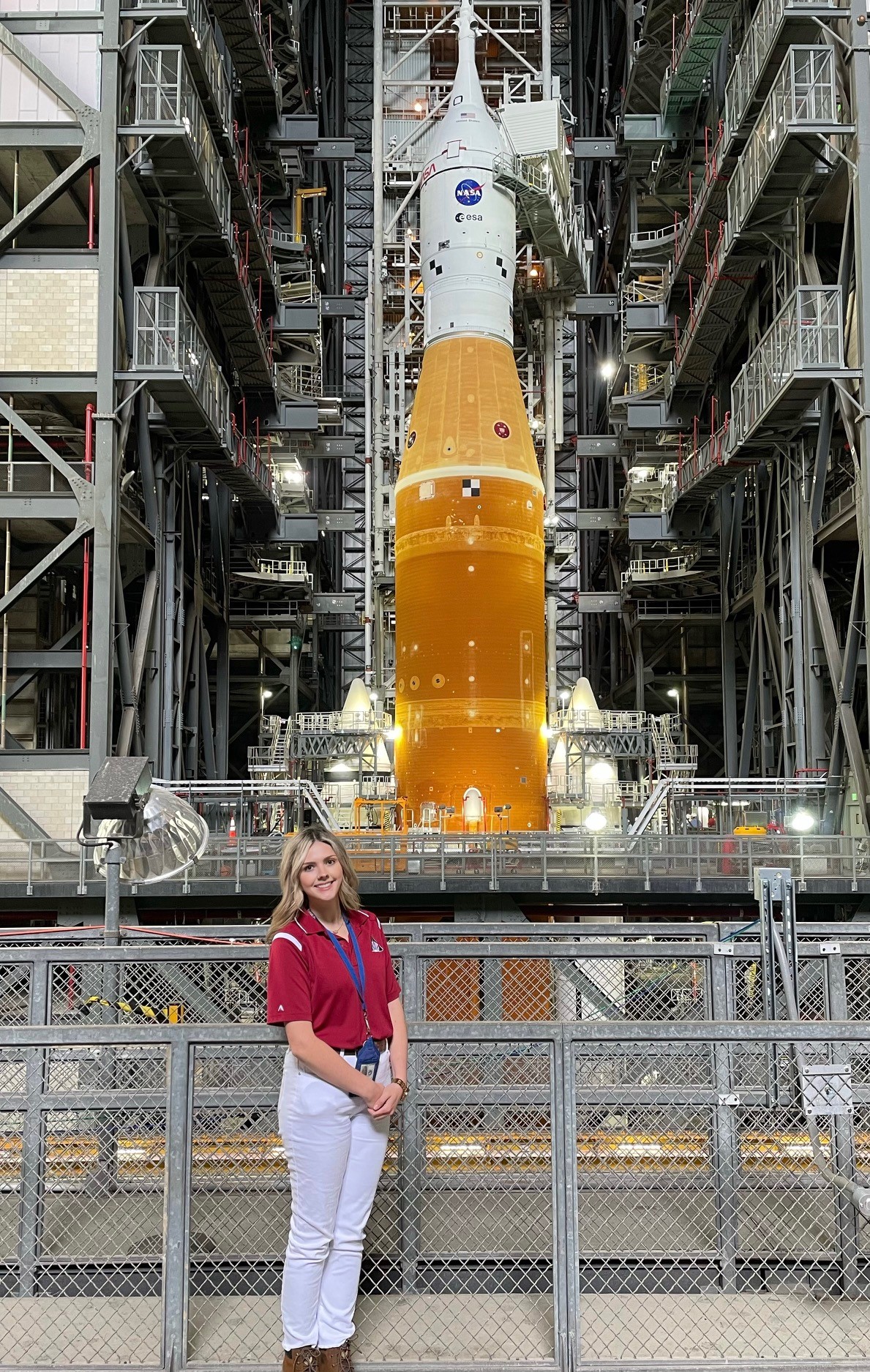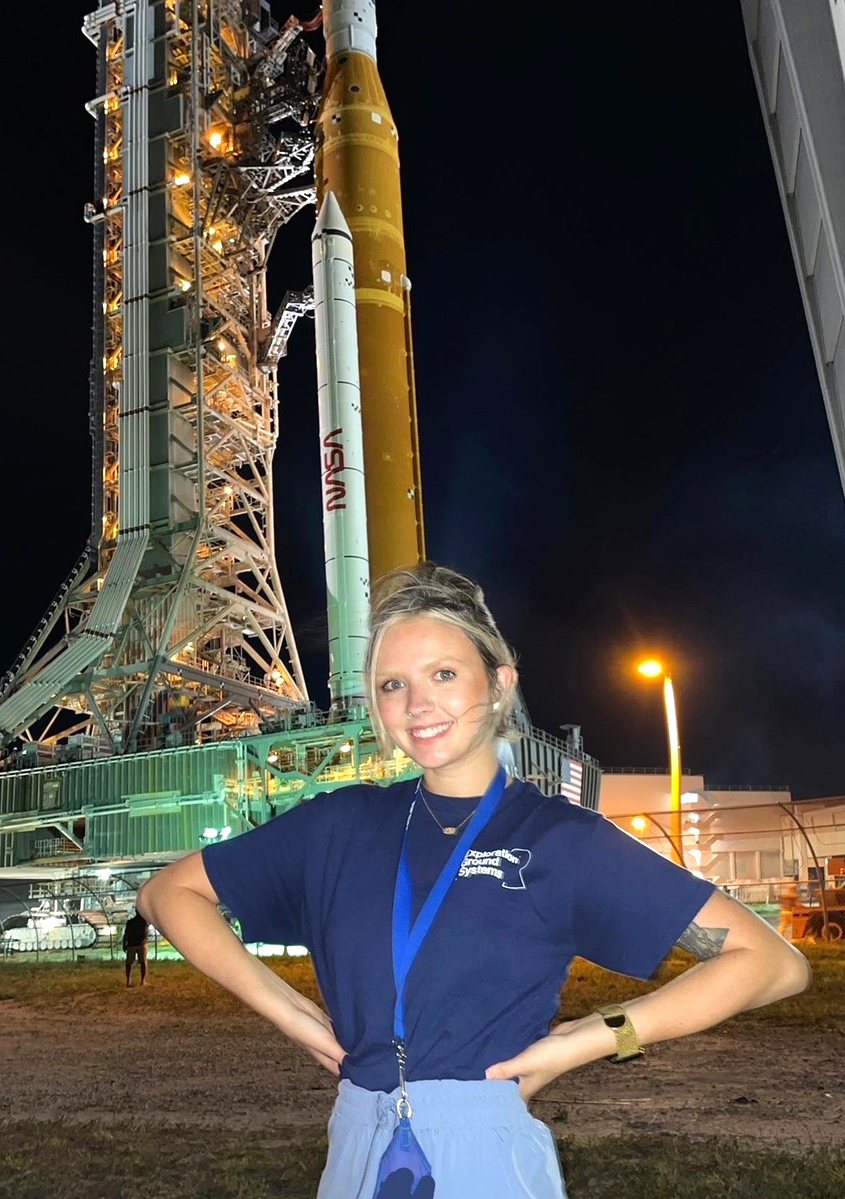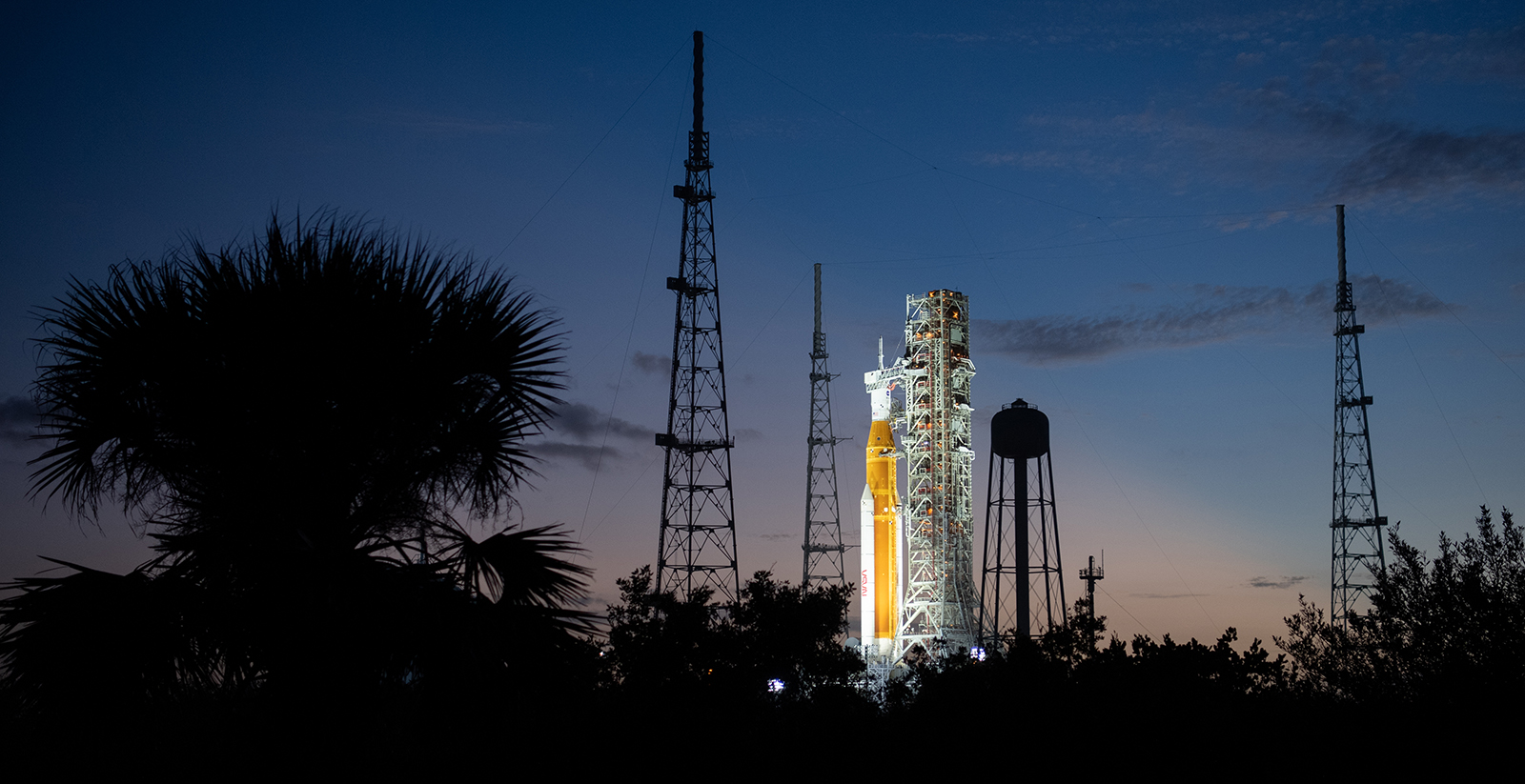She made sure her tickets were fully refundable. Still, Alora Mazarakis (’21) hoped that when she joins her family for Thanksgiving, she would have something unforgettable to be thankful for: A successful Artemis launch.
On launch day, you may have heard Mazarakis.
“When we’re counting down when you hear ‘all systems go,’ we say: ‘Communications and tracking, go for launch. That’s us.”
How did she get here, in the launch room for Artemis I, the first of several planned missions to the moon and Mars?
Although she is not a pilot, her life has always been aviation-adjacent. Her father is a 757 and 767 pilot with UPS who proudly delivers frequent updates on her career to colleagues.
“We all feel so honored to be putting humankind back on the moon.”
– Alora Mazarakis (’21), radio frequency engineer, NASA
After she earned her undergraduate degree in electrical engineering from the University of Louisville, she realized she wanted to work for NASA and that an Embry-Riddle degree would boost her chances.
“I chose Embry-Riddle for my master’s degree in electrical and computer engineering because growing up, I always knew that was where you go for aerospace.” There could soon be another Eagle in the family. Her brother is working on his private pilot’s license and plans to apply to Embry-Riddle.
From Researcher to Console Engineer
“I didn’t know what I wanted to specialize in when I applied, but I was already working for a contractor at NASA that builds payloads for the International Space Station,” she says.
She worked in the Wireless Devices and Electromagnetics (WiDE) lab as she pursued her degree, which heightened her interest in Radio Frequency (RF) and Avionics. Her interest grew as she worked with lab director Dr. Eduardo Rojas and enjoyed his class on space satellites, where she fell in love with antenna design.
“It was never my intent to become an RF engineer,” she says. “Working in the WiDE lab, I realized how cool that was.”
Her timing was perfect. NASA opened up an RF engineering position months before she completed her degree. She immediately landed a position to work as a console engineer in the firing rooms on Artemis’ RF systems, a small but highly specialized team.
“Even for electrical engineers who have not specialized in electromagnetism and radio frequency, it is all magic,” she says.

All in the Details
She is patient and practiced at explaining just what role the “RF meta-subsystem” plays in a project such as Artemis.
“Picture the rocket on the launchpad,” she says. “We can get telemetry from the rocket through the umbilicals and through the radios the same way your phone gets data from the internet or satellites. But once the rocket launches, the only communication is through radio frequency. My team designs and then tests and validates the status and health of all antennas on the rocket, which send operational and development flight data, including rocket metrics and then all the video.”
So when you see the Orion capsule in space and witness the core stage separation, thank the RF engineers for the video.
“All that data is downlinked via RF. And it is not even just that. Information about the propulsion systems, the engines, avionics, cryogenics, the flight termination system, everything has to come down after launch through antennas.”
The intricate interconnection of subsystems drives collaboration, she says. “We need to talk to certain other subsystems to power something on, for example, before we can power our systems on. Some of the data downlinked through our antennas comes from other subsystems. We make sure their data looks good. Some of our power systems, such as batteries and switches, aren’t controlled by us. That is done by the Electrical Power System team. So, we have to communicate through all of those avenues because everything is so deeply interconnected.”
“It’s not easy. It’s rocket science.”
– Alora Mazarakis (’21), radio frequency engineer on NASA’s Artemis I Mission
The propagation and radiation patterns of the antennas in a rocket such as Artemis are highly sensitive and not without vulnerabilities. There are also challenges related to the area surrounding the launchpad.
“Kennedy Space Center has marsh and water everywhere. So if antenna waves bounce off water, that can change their paths or signal strength at destination. Also, having a lot of antennas close together can create multi-path issues – basically, antenna waves affect each other.”
Mazarakis says simulations preceding the launch entailed long days but provided fantastic learning experiences that test “known” problems as well as some curveballs. Every engineer in the fire room was expected to respond exactly as they would on the actual launch day.
“We have a list of launch commit criteria. Metrics of our systems have to be at a specific place to launch. For example, if a current on a battery is below the limit, that is a problem. And if we don’t solve it, a solution could be no-go for launch. We have to be prepared to run through all our contingencies.”
Her T-Minus To-Do List
Mazarakis expected an early day on Nov. 16 that would start in the fire room in the Launch Control Center 12 hours before launch. As the launch neared, the console engineers are joined by press and VIP guests in the launch center, which she compares to a computer lab, with people staring intently at their screens.
“I guarantee it is the quietest room you will ever be in with 100 other people,” she says.
“We all keep to a very tight schedule. I do Early Activation, which means we power-up our systems early so other systems can test their metrics with our systems metrics in mind. Then we monitor and make sure that everything is looking good all through that time.”

At T-minus 3 hours, she transitioned to the Radio Frequency Telemetry Station. This communications hub allows the team to see all communications to and from the rocket by both hardline and RF. Any troubleshooting happens in real time.
“Everybody is on their A-game,” she says. ”If there’s an issue, it’s on us to call out what we’re going to do. Of course, the launch director has the final word, but she will listen to our recommendations.”
Mazarakis knows from scrubbed launches that the days feel endless but full of adrenaline. She may be in one of the most exciting locations when Artemis launches, but there are limitations to her insider perspective.
“It is heartbreaking not to run outside to see the actual launch, but we do the job we signed up for. Actually, at T-minus 0, we hand off to Johnson Space Center and it becomes Houston’s mission.”
Bringing Boxed Cornbread
After a collective sigh of relief, it is time for beans and cornbread, a NASA tradition dating back to 1981.
“Everybody brings their favorite bean recipe in a crockpot or cornbread for a potluck,” she says. “In the launch control center lobby, there is an exhibit with fossilized crockpots and stories. If there is no launch, you don’t eat the beans. So a lot of beans have been tossed over the years.”
She and female colleagues were considering bringing ties so they could participate in another tradition.
“I hear that it’s a military thing. If it’s your first launch at a console, they cut your tie.”
In a somewhat more informal nod to tradition, she expected that post-launch, NASA engineers will pack local bars.
After the Moon?
Working for NASA while making history is a “pinch me” experience.
“We work long, long hours and you get tired,” she says. “You get mentally exhausted. Then you look around and think, the greatest engineers of all time sat in the same room.”
She can see herself working for NASA for the rest of her career — wherever that takes her.

“Maybe Mars? Right now, I’m focused on getting this rocket off the ground. I tell people to ask me about my future in a year-and-a-half after launch, after I’ve calmed down.”
When Artemis lifts off, Mazarakis said she would be cheering, for the team and for the future of spaceflight.
“I always just want to impart on people that this is human space flight. It’s not easy. It’s rocket science. Sometimes, you roll the rocket back and, sometimes you scrub a launch. Eventually, we will put astronauts in the Orion crew module safely. That’s what matters to us.”
Her coworkers tease her a little about her energized enthusiasm for her work, the mission and science itself. She knows they feel it, too.
“We all feel so honored to be putting humankind back on the moon,” she says. “I want everybody to read about Artemis and go to nasa.gov and learn about all of the things that NASA is doing. Learn about space.
“This time, we go to the moon for science. We will increase our gravitational research and even improve upon all the things we learned from the International Space Station. And NASA does so much more, contributing to Earth sciences and weather science and oceanographic science. NASA has their hands in absolutely every type of science that we do in the United States.”
She had one wish beyond a successful launch for Artemis I.
“I hope my excitement and energy about Artemis and NASA is contagious.”
